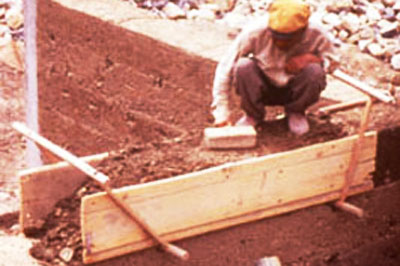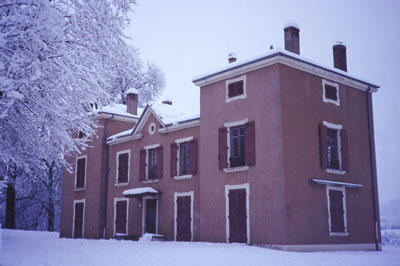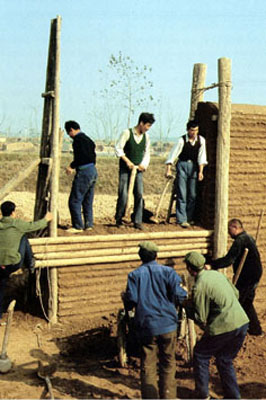Rammed earth, also known in French as pisé de terre or simply pisé has been used since ages worldwide like many other earth techniques. The earth is mixed thoroughly with water to get a homogeneous humid mix. This humid earth is poured in a form in thin layers and then rammed to increase its density. The increase of density increases as well the compressive strength and the water resistance. Ramming was traditionally done by hand. Since a few decades, ramming is being done mechanically with pneumatic rammers (see the webpage on modern rammed earth).
The worldwide tradition of rammed earth construction has shown that it is possible to achieve long lasting and majestic buildings from single to multi storey. Wonderful heritage can be found in countries such as France, Spain, Morocco, China, and all over the Himalayan area. One can see numerous and wonderful examples with all kinds of buildings:
• Farms, or rural houses, chateaux and apartments in Europe
• Entire villages in North Africa
• Parts of the great wall of China
• Buildings in most of the Himalayan regions of Tibet, Bhutan, Nepal, Ladakh
• Widespread examples in South America
Soil identification
Like any other earth building technique, one should select the best soil, according to the requirements. Knowing that the best soil for rammed earth is preferably sandy or gravely rather than clayey, one should take a lot of care about the clay content. Worldwide, the skill and knowledge of people has led them to choose rammed earth when the soil was more sandy or gravely. When the local soil was more silty or clayey they chose other techniques like Adobe, Cob or Wattle and Daub.
Preparation
After being excavated, the soil is thoroughly sieved, to break the lumps and make it lighter. Big rocks should be removed but some stones could be kept. If the natural soil is too dry, it should moistened and mixed so as to get a uniform humid mix.
Formwork types
Two techniques have traditionally been developed. They used either horizontal or vertical formworks.
| The horizontal technique was used in many parts of the world. Strips of walls were built horizontally and their height varied from 30 to 90 cm.
The formwork consisted of 2 wooden panels held together with wooden clamps and keys, which were tightened with ropes. Once one portion of a wall was completed, the formwork was immediately dismantled and moved further along the side of the wall, as showed here in Morocco or China.
| 
Morocco

China
|
| The vertical technique was used in a few places in the world: mainly in Tibet, China and one region of France (Bugey).
The walls were built vertically to their full height at once. Long poles were anchored in the ground to hold side panels, which were made of wood and tightened with rope. The entire height of the wall was built course after course. Once a course was completed, the side panel was raised to ram a next course and the process went on till the entire height of the wall was completed.
| China

China |
| Humid soil was evenly poured into the formwork to get a regular course of about 12-15 cm thickness. Ramming was traditionally done by hand.
The soil is first rammed along the sides of the panels and the central portion of the wall is rammed immediately after that.
Every course is rammed till the rammer hitting the soil gives a clear sharp sound and the rammer is not doing anymore marks on the course.
Once a course has been completed, the process goes on in the same way for the following courses till the maximum height of the panels. Immediately after completion, the formwork is removed and shifted either sideways in the case of the horizontal technique or lifted up for the vertical technique.
| 
India, Ladakh, Losar

Morocco, North Atlas
|

France - Château de Reyrieux, 17th century
|

France, Dauphiné - Château, 19th century
|

France, Villefontaine - Ex bourgeois´ house
|

France, Saint Siméon de Bressieux - Longest building in Europe
|

France, Saint Siméon de Bressieux - Social housing, 19th century
|

France, Charavines - Farm house
|

Spain - Castillo de Biar, 12th century (photo Paul Jaquin)
|

Spain - Castillo Baños de la Encina, 10th century (photo Paul Jaquin)
|

Spain - Castillo Baños de la Encina, 10th century (photo Paul Jaquin)
|

Spain - Castillo Baños de la Encina, 10th century (photo Paul Jaquin)
|

Spain, Maluenda - Church Santas Justa y Rufina (photo Paul Jaquin
|

Spain, Villafeliche - Church (photo Paul Jaquin
|

>Morocco - Village in the North Atlas
|

Morocco - House in the North Atlas
|

Morocco - House
|

India, Ladakh - Basgo Gompa
|

India, Ladakh - Basgo village
|

India, Ladakh, Basgo - House
|

India, Ladakh, Leh - Castle
|

India, Ladakh, Leh - Tsemo Gompa
|

India, Ladakh - Spituk Gompa
|

India, Spiti - Lalhung temple, 10th century
|

India, Spiti - Mane village
|

India, Spiti - Tabo village
|

Tibet, Lhasa - Potala palace
|

Tibet, Amdo - Rebkhung monastery
|

Tibet, Amdo - House
|

China, Fujian Province - Village / house of Hakkas clan
|

China, Fujian Province - Village / house of Hakkas clan
|

China, Fujian Province - Yijing Building at Shangyang
|






































